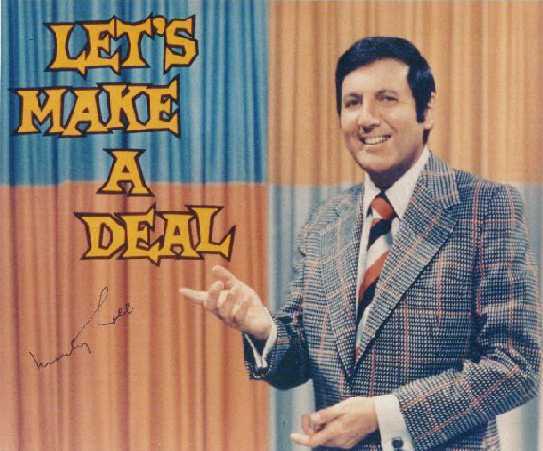I was proctoring my students during the standardized tests last week and thinking of how we try to train them to try to eliminate a couple of obvious wrong answers before guessing. Then I remembered the Monty Hall Problem. You remember, maybe, the show Let’s Make a Deal. People would dress up in crazy costumes and act crazy in hopes of wheeling and dealing with host Monty Hall. At some point a lucky contestant had the chance to win what was behind Door #1, Door #2, or Door #3. After making a choice, the contestant would be shown what was behind one of the remaining doors and given the chance to change the choice or stay with the original pick. (Go Here and here and here for a lot more on the MHP.)
It turns out, theoretically and empirically, that you have a better chance of winning if you take the offer and change your pick, than if you stick with your first choice.
In the afternoon, in our 17 minute class, I posed this problem to my 8th grade Algebra for High School Credit class: “Would it be a good guessing strategy, if at the end of the test you went back and changed all of your guesses to another choice?” The arguments on both sides flew back and forth. At the end of class I told them to go do some research. Several came back the next day to continue the argument, others to point out that my question was different. I felt like I was in a college seminar.
In what remained of our 17 minute period, I taught them a trick. Take any 3-digit number in which the first and last digits have a difference of at least two. So 368 is ok, but 364 is not. I’ll use 368. Please choose a number and play along. Write your number backwards to get a second number. Now I have 368 and 863. Subtract the smaller number from the larger. For me 863 -368 = 495. Now take that number and get a new number by writing it backwards. So I have 495 and 594. Add the two together: 459 + 594 = 1089. You got 1089, too, didn’t you? Everyone does if they do it right.
“How does that work?” thirty students replied at once.
It took two 17 minute periods to prove that I could read their minds just like the Flash Mind Reader and for them to figure out how. Follow the link and see if you can. My kids made two assumptions – that it was math and that I wasn’t really reading their minds. They came up with a list of things they could observe and looked for patterns and made predictions and found which predictions worked and which didn’t. Finally, Jesus blurted out, “I’ve got it, all you do is….” (I don’t want to spoil it.)
My students did more deep thinking and inquiry in those four 17 mintue periods than in all the hours spent to prepare for the tests.
(Note: the picture on top is from www.thegameshoetemple.com/tribute/hall.htm)









